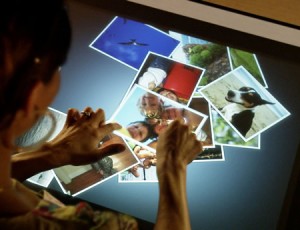Share This
Related Posts
Tags
Tabletop Computing
By Yardi Blog Staff on May 17, 2012 in Technology | 2 Comments
Has it really already been two years since Microsoft debuted their innovative Surface tabletop computer? That’s a trick question – it’s actually been five years, a veritable eternity in the lifetime of any consumer computing product. Surface was supposed to be the first shot of a revolution in business and game computing, the vanguard of a bold new enterprise technology.
How did that work out?
Microsoft introduced Surface in May 2007 and the first units shipped a year later. Opportunities to view this curious creature in the wild have been vanishingly rare. Harrah’s picked one up for the bar at their Rio Casino in Las Vegas; Disneyland added one to their Tomorrowland exhibit; Sheraton put units in the lobby of five of their hotels worldwide; MSNBC used a Surface on-air during their 2008 election coverage. But they haven’t reached the mainstream business market anticipated by Bill Gates when he forecast a five year time frame for product roll out.

After Surface, there were several attempts by various manufacturers to turn tabletop computing into a viable technology, including the Linux MPX, Ideum MT-50, spinTOUCH iBar, and the most recent iTable from PQ Labs. None has been able to meet even the minimal success achieved by the Surface.
You’re more likely to see Bigfoot on a Segway or Nessie talking on an iPhone than a human using a tabletop computer… where did they go? Tablets bear most of blame for taking the thunder out of the tabletop computing storm. Tablets and tabletops feature quite a bit of overlap, including their basic design and the touch interface. However, tablets add the ultimate conveniences of portability and a scale that is comfortable – it’s just not easy to relate to a tabletop computer, or consider it as something other than a lavish novelty.
Ironically, the same tablet technology that has buried tabletops to this point may provide a boost to the technology moving forward. Now that consumers are familiar and comfortable with large-format touchscreen interfaces, they may be more enthusiastic to see new iterations of the platform – the ready availability of convenience typically makes users bolder and more willing to explore new innovations.
Property management firms have found that adding large screen computers (with a mouse) in self serve kiosks to building lobbies and model units is one way to capture the interest and engagement of prospects. They can zoom in on property amenities, view and compare floor plans and model layouts, and see an interactive map of the surrounding neighborhood and services. (See an example of an interactive kiosk display for a Dallas property.) After piquing their interest and a successful unit tour, the prospect can return to the kiosk to fill out an application and submit it directly into the property’s application database.
Such kiosks, mostly found in Class A properties, could move to the next generation with tabletop computing.
Earlier this year Microsoft and Samsung rolled out Surface 2.0 – here is the spiel direct from the horse’s mouth:
Microsoft has lowered the price significantly (about $8500 to get started) and state-of-the-art PixelSense technology replaces bulky cameras – the screen responds not just to touch, but can sense objects placed on it and respond appropriately. Microsoft is offering a host of new enterprise apps – some custom-tailored to order – to encourage businesses to explore the possibilities that tabletop computing can offer. Those who have adopted the technology are divers, ranging from BMW to AT&T to fighter jet maker Dassault. But you don’t see any high profile property managers on the user roster, probably due to the high up-front cost of these devices.
Is there a place for tabletop computing within the real estate/property management sector? Absolutely. Large screen size and optimized interactivity allows clients to efficiently survey multiple properties, compare and contrast, manipulate views, call up several pages of related data on a single screen, and more. The capabilities of PixelSense are only beginning to be explored. If nothing else, tabletops have proven effective at grabbing and maintaining viewers’ attention – worse comes to worst, bored clients can be entertained with a game of super-sized Angry Birds.
Does tabletop computing still have that gee-whiz-let’s-take-a-trip-into-the-future cache, or has its initial failure to catch fire dimmed its appeal? Can we find new applications to make the technology relevant to property management?

I’m imagining this technology in the property management context described here, and I’m seeing children playing with it, and many people touching the surface of this thing, and I’m wondering if it comes with a built-in hand sanitizer dispenser? I don’t think surface computing makes a lot of sense. It is not ergonomic to stare down at a thing like this (though a touchscreen display on a wall might work in some applications) and flat surfaces just beg to have beverages and other objects placed on them. Unfortunately I think some of these developers might need to realize that not EVERYONE dreams of marrying World of Warcraft and table-top D&D games into one immersive experience…
Great thoughts, Julie. I agree that the image created by “tabletop” does present some hurdles. Who wants to spill Coke on the $8500 office computer?! But what if we took that tabletop and flipped it 90 degrees? Inset it in the wall? More like a window and the screen saver could be a curtain. “Come on in. Open the blinds to your new home.” With a mere swipe to the side they are effectively standing in their potential living room, looking around, changing floor plans. Imagining it this way, have we expanded the potential applications & possibilities? If so, what other uses can you predict?